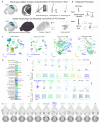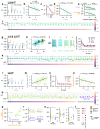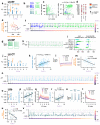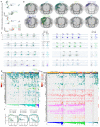This is a preprint.
Connecting single-cell transcriptomes to projectomes in mouse visual cortex
- PMID: 38168270
- PMCID: PMC10760188
- DOI: 10.1101/2023.11.25.568393
Connecting single-cell transcriptomes to projectomes in mouse visual cortex
Abstract
The mammalian brain is composed of diverse neuron types that play different functional roles. Recent single-cell RNA sequencing approaches have led to a whole brain taxonomy of transcriptomically-defined cell types, yet cell type definitions that include multiple cellular properties can offer additional insights into a neuron's role in brain circuits. While the Patch-seq method can investigate how transcriptomic properties relate to the local morphological and electrophysiological properties of cell types, linking transcriptomic identities to long-range projections is a major unresolved challenge. To address this, we collected coordinated Patch-seq and whole brain morphology data sets of excitatory neurons in mouse visual cortex. From the Patch-seq data, we defined 16 integrated morpho-electric-transcriptomic (MET)-types; in parallel, we reconstructed the complete morphologies of 300 neurons. We unified the two data sets with a multi-step classifier, to integrate cell type assignments and interrogate cross-modality relationships. We find that transcriptomic variations within and across MET-types correspond with morphological and electrophysiological phenotypes. In addition, this variation, along with the anatomical location of the cell, can be used to predict the projection targets of individual neurons. We also shed new light on infragranular cell types and circuits, including cell-type-specific, interhemispheric projections. With this approach, we establish a comprehensive, integrated taxonomy of excitatory neuron types in mouse visual cortex and create a system for integrated, high-dimensional cell type classification that can be extended to the whole brain and potentially across species.
Figures







References
-
- Golgi C. Sulla strutura della sostanza grigia del cervello. Gazzeta Medica Italiana, Lombardia. 33, 244–246 (1873).
-
- Cajal S R. y. Histologie du système nerveux de l’homme et des vertébrés (1911).
-
- Dorkenwald S. et al. CAVE: Connectome Annotation Versioning Engine preprint (Neuroscience, 2023).
-
- Gao L. et al. Single-neuron projectome of mouse prefrontal cortex. Nature Neuroscience 25, 515–529 (2022). - PubMed
Publication types
Grants and funding
LinkOut - more resources
Full Text Sources
Research Materials
Miscellaneous
